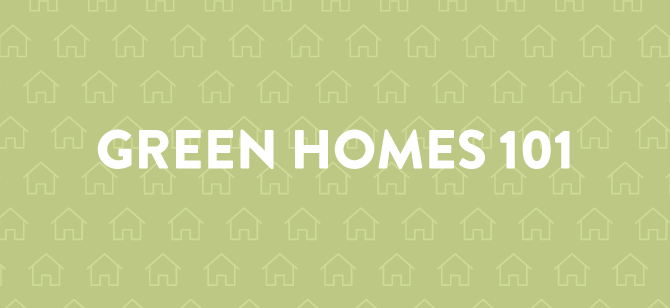Green Homes 101
6/7/2020

According to the National Association of Home Builders, single-family green residential construction has grown dramatically, from 2 percent in 2005 to 23 percent in 2013. Green home building—or retrofitting—is clearly a booming industry. But it may be intimidating to think about making your home green and what that involves. Start at the beginning, and educate yourself to ensure that your efforts are as effective as possible.
What is a green home?
Simply put, a green home uses less energy, water and natural resources compared to a standard home. It is more efficient, and so creates less waste. In addition, a green home can be a much healthier habitat for the people living inside.
You can build a sustainable home, or you can make changes later to make it more green. A “green makeover” can happen all at once, or it can be a gradual process.
Why make your home green?
Benefits to living in a green home include greater durability, lower energy costs and increased health for those dwelling inside the building.
Saving your breath
- Green homes use nontoxic building materials to help combat indoor air pollution. Unhealthy air inside a dwelling can pose serious health risks for residents.
- Natural ventilation in green homes, as well as mechanical ventilation systems that filter fresh air from outside, keep residents breathing easy.
Saving money
- The typical household spends about $2,150 a year on residential energy bills. LEED-certified homes can save 30-60 percent on those bills.
- If initial green construction costs seem high, it is often because many architects, homebuilders, and other industry professionals don’t have the knowledge and experience to cost-effectively plan, design and build a green home. Make sure you find a professional familiar with green building techniques.
- An increasing number of insurance companies offer discounts on policies covering green homes. Similarly, several mortgage companies offer discounted loan rates for homebuyers.
- A green home often uses higher-quality building materials and construction processes than a standard home—and better materials mean fewer repairs.
- The resale value of a green home is often higher than that of a comparable standard home, and the market demand continues to rise. The same cachet is often attached to rental units.
- Local, state and federal governments are increasingly offering tax breaks and other incentives for building LEED homes or adding green features to your home.
Saving the environment
- Residential cooling and heating alone make up 20 percent of annual energy use in the United States. When you add in lights, appliances and other electronics, homes use a huge amount of energy. Most of this comes from greenhouse gas producers such as oil and coal, in turn contributing to global climate change. Green homes use 40 percent less energy.
- Some green homes further reduce our dependence on conventional energy by using alternative sources such as solar, wind, geothermal and biomass.
- Efficient plumbing and bath fixtures, drought-tolerant landscaping and water-conserving irrigation systems help green homes use less water.
- Many green building materials have significant recycled content, from carpets and floor tiles made from recycled tires to structural materials salvaged from demolished buildings. They also use materials made from rapidly renewable materials such as bamboo, hemp, agrifibers and soy-based products. And if you use wood certified by the Forest Stewardship Council, you are helping to promote socially and environmentally beneficial forestry practices.
- Building a standard 2,500-square-foot home creates approximately 2 tons of construction waste that ends up in landfills. Construction of a green home, however, can generate far less waste.
By deciding to make your home more green, you are also making a commitment to be part of a more sustainable world.
Back
